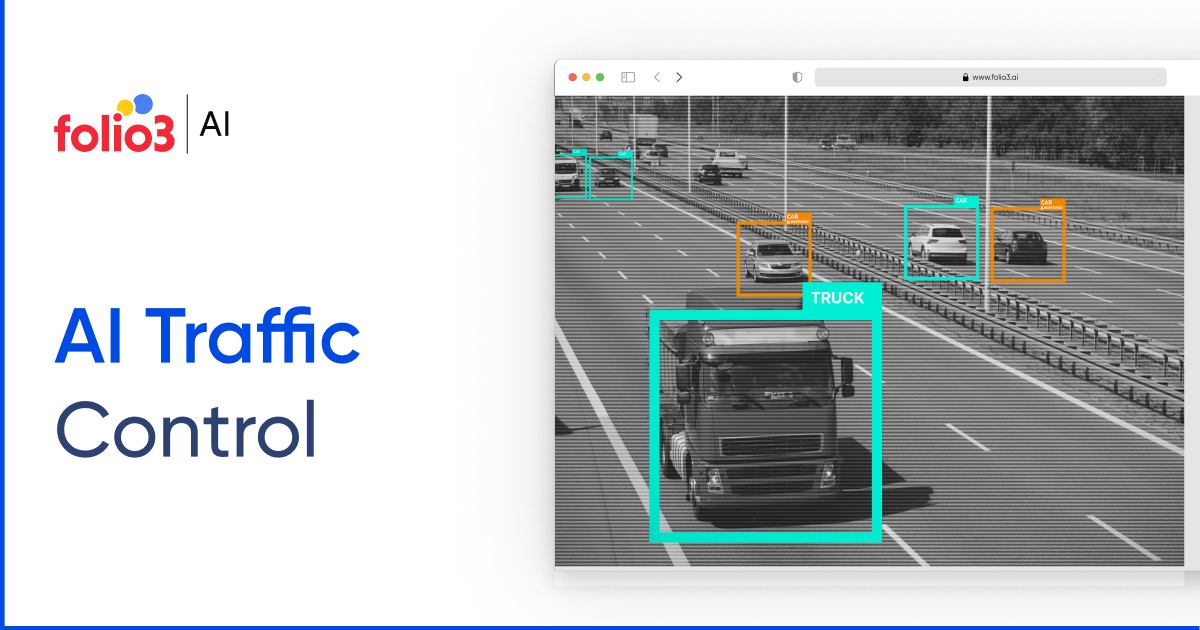The global population is steadily increasing, and with it, the number of vehicles on the road continues to surge. This rise in car ownership is significantly impacting urban infrastructure, while countries are simultaneously grappling with major challenges like climate change and growing traffic congestion.
It highlights the continued need for smart and innovative solutions. One glaring example is the recent collapse of the Baltimore Key Bridge in the USA, which not only disrupted logistics and commerce but also revealed how fragile our infrastructure and traffic systems still are.
Even with smart cities on the rise, traffic control remains a critical need, like a conductor guiding a chaotic orchestra of cars, ensuring every movement happens in harmony. This is where artificial intelligence steps in. AI in traffic control offers an easy, faster, and more adaptive way to manage the ever-growing demands on our roads.
Keep reading to explore what AI in traffic control really means, the benefits it brings, and how it’s already transforming cities across the country.
What is AI Traffic Control?
The synergy of artificial intelligence technologies, such as machine learning, computer vision, and predictive analytics, is being used to monitor, manage, and optimize the flow of vehicles on roads and highways. Instead of relying on primitive traffic systems with fixed timers or basic sensors, AI-driven systems analyse real-time data from cameras, GPS, and sensors to make effective decisions instantly.
For example, an AI-powered traffic system detects congestion at a busy intersection and adjusts the traffic light timing in real time to ease the buildup—something traditional systems fail to do without manual intervention.
It’s a prominent and highly demanded AI-powered solution. Its value is evident in sources like PR Newswire and TheTrucker.com. Despite significant investments in roads, signal upgrades, and public transit expansions, traditional traffic control systems often struggle to adapt to dynamic conditions, underscoring the continued importance of effective traffic management.
Key Applications of AI in Traffic Control
The growing need for AI traffic control is evident when looking at sources like Our World in Data and UN-Habitat. For instance, a recent INRIX report revealed that New York City drivers spent an average of 102 hours in congestion last year, placing them among the worst in the nation. This highlights the critical need for smarter, AI-driven solutions, which we address below by outlining key applications in traffic management.
1. Smart Traffic Lights
AI enables adaptive traffic signal systems that adjust in real-time based on traffic flow. Using live data from cameras and sensors, these smart lights can extend green lights on congested roads or prioritize cross-street traffic during less busy hours. This reduces idle time, fuel consumption, and vehicle emissions, while significantly improving traffic flow during peak hours.
2. Accident Detection and Emergency Response
AI systems equipped with computer vision and audio analytics can detect accidents, sudden stops, or abnormal driving behavior instantly. Once identified, these systems can notify emergency services with precise location data, enabling quicker response times. Some cities also use AI to automatically reroute traffic around the incident zone, minimizing secondary accidents and reducing delays.
3. Traffic Flow Prediction
Machine learning algorithms analyze historical and real-time traffic data to predict congestion patterns before they happen. This enables traffic control centers to proactively manage flows, whether it’s adjusting signal timing, warning drivers through digital signage, or updating navigation apps. Predictive analytics also helps city planners make long-term infrastructure decisions based on accurate forecasts.
4. Vehicle Counting and Recognition
AI-powered vehicle counting systems can accurately count vehicles and classify them by type (car, truck, bike, etc.). This data is essential for understanding traffic composition, measuring road usage, and planning future infrastructure. It also helps in evaluating the effectiveness of new traffic policies or lane reconfigurations.
5. License Plate Recognition & Law Enforcement
AI systems can scan license plates in real-time to detect stolen vehicles, track traffic violations (like running red lights or illegal parking), and issue automated fines. This not only improves law enforcement efficiency but also acts as a deterrent, encouraging safer driving behavior in high-risk zones such as school areas or construction sites.
6. Autonomous Vehicle Integration
As self-driving cars become more common, AI-driven traffic systems will play a crucial role in coordinating between autonomous and human-driven vehicles. AI can help manage mixed traffic environments by communicating with connected vehicles, predicting movement patterns, and ensuring smooth, safe transitions at intersections or merging lanes.
Benefits of AI Traffic Control
As cities around the world continue to grow, traffic congestion, safety concerns, and environmental pressures are becoming impossible to ignore. According to the INRIX Global Traffic Scorecard, drivers in major urban centers lose dozens of hours each year to traffic jams, costing billions in productivity and fuel. Even with investments in public transit and road expansion, traditional traffic control methods can’t keep up with today’s dynamic conditions. AI-powered systems offer a smarter, data-driven alternative that delivers real-time responsiveness and long-term planning insights. Here are the core benefits:
Reduced Congestion and Commute Times
AI traffic systems adapt to real-time conditions using data from road sensors, GPS, and cameras to adjust signal timings and optimize flow. For example, an AI-based system implemented in Pittsburgh cut travel times by 25% and wait times by 40%. These systems help ease peak-hour gridlock, reduce unnecessary stops, and create smoother commutes without the need for manual traffic control.
Improved Road Safety
Human error is responsible for the vast majority of road accidents. According to the World Health Organization (WHO), 1.19 million people die in road crashes every year. AI technologies can detect dangerous driving behavior, identify accidents instantly, and alert emergency services faster than human operators. In some cities, AI systems also help prevent secondary collisions by automatically rerouting traffic away from incident zones.
Lower Emissions Through Efficient Routing
Traffic congestion leads to excessive idling and stop-and-go movement, which in turn increases fuel consumption and emissions. The U.S. Department of Energy found that urban driving inefficiencies can reduce fuel economy by up to 40%. AI-powered traffic control helps optimize routes and signal timing to keep vehicles moving, reducing carbon output and supporting cleaner, healthier urban environments.
Real-Time Traffic Analytics and Monitoring
Unlike traditional systems that rely on static timers or scheduled adjustments, AI continuously processes live data to provide traffic control centers with up-to-the-minute insights. Whether it’s a public event, weather disruption, or unexpected spike in traffic, AI systems can detect and respond instantly. Cities like Singapore and Miami-Dade have adopted these technologies to improve real-time visibility and management.
Better Infrastructure and Policy Planning
AI doesn’t just manage today’s traffic—it informs tomorrow’s cities. By analyzing trends in vehicle flow, congestion hotspots, and road usage over time, AI provides urban planners with accurate, actionable data. This helps governments and municipalities invest smarter in infrastructure, whether that means redesigning intersections, adding new lanes, or adjusting traffic laws. Cities like Los Angeles and Barcelona are already leveraging AI insights to build more responsive urban environments.
Challenges and Limitations
While the advantages of AI traffic control are clear, implementing such advanced systems is not without its challenges. As cities explore the shift from static infrastructure to intelligent systems, several limitations still need to be addressed to ensure sustainable, equitable, and effective deployment.
Data Privacy and Surveillance Concerns
Many AI traffic control systems rely heavily on real-time video feeds, license plate recognition, and GPS data to operate effectively. While this data helps improve traffic flow and public safety, it also raises serious concerns about surveillance and citizen privacy. Without strong data governance frameworks, there’s a risk of overreach or misuse of personal information, especially in systems using facial recognition or tracking technologies. Cities must prioritize transparency and establish clear regulations to protect public trust.
High Infrastructure Costs
Deploying AI-based traffic control solutions requires significant upfront investment. From installing high-resolution cameras and sensors to building data centers and software platforms, the cost can be a major barrier, especially for developing regions or smaller municipalities. Even in larger cities that have adopted pilot programs, like Los Angeles or Singapore, scaling across the entire urban area requires long-term funding strategies and public-private partnerships to offset costs.
Integration with Legacy Systems
Most existing traffic infrastructure was not designed with AI in mind. Integrating AI with older systems, such as analog traffic lights, basic road sensors, or fragmented databases, can be complex and time-consuming. Without seamless interoperability, cities risk creating data silos or operational delays that reduce the effectiveness of smart systems. This makes a strong case for phased upgrades and modular implementation strategies to ease the transition.
Dependence on Data Quality
As highlighted earlier, AI traffic control thrives on real-time, high-quality data. If that data is incomplete, outdated, or inaccurate, the AI’s decisions can lead to poor outcomes, from misdirected traffic to false emergency alerts. Weather conditions, sensor failures, or communication disruptions can all affect the consistency of data inputs. Ensuring reliable infrastructure and ongoing maintenance is crucial to keeping these systems functional and trustworthy.
Final words
As urban life continues to evolve, the demands on our infrastructure are growing more complex. Traditional traffic management systems are no longer enough to handle the increasing congestion, safety risks, and environmental concerns that come with rapid urbanization. To keep pace, cities must adopt innovative infrastructure like AI-driven traffic control systems. These technologies provide adaptive, real-time solutions that optimize traffic flow, enhance safety, and reduce emissions. While challenges like data privacy and high costs remain, the need for smarter, more efficient traffic management is clear. Embracing AI is key to building a future where cities are safer, more sustainable, and better equipped to meet the needs of modern society.

Areeb is a versatile machine learning engineer with a focus on computer vision and auto-generative models. He excels in custom model training, crafting innovative solutions to meet specific client needs. Known for his technical brilliance and forward-thinking approach, Areeb constantly pushes the boundaries of AI by incorporating cutting-edge research into practical applications, making him a respected developer in folio3.









